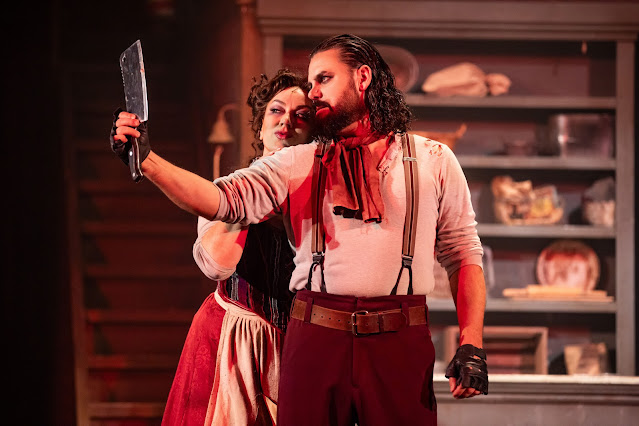 |
| Antoinette Halloran and Ben Mingay in "Sweeney Todd: The Demon Barber of Fleet Street" |
Music and
Lyrics by Stephen Sondheim – Book by Hugh Wheeler
Directed by
Stuart Maunder – Conducted by Simon Holt
Set and
Costumes designed by Roger Kirk – Lighting Designed by Philip Lethlean
Sound Design
by Jim Atkins – Lighting realised by Jason Morphett
Drama
Theatre, Sydney Opera House July 26 – August 27, 2023.
Performance
on July 26 reviewed by BILL STEPHENS

Antoinette Halloran (Mrs Lovett) - Benjamin Rasheed (Adolfo Pirelli) - Ben Mingay (Sweeney Todd)
The 50th
Anniversary celebrations of the Sydney Opera House provided an opportunity for this
Sydney season of Victorian Opera’s acclaimed production of the Stephen Sondheim/Hugh
Wheeler Grand Guignol masterpiece, “Sweeney Todd: The Demon Barber of Fleet
Street”; a production Victorian Opera shares with New Zealand Opera.
This
production stars Ben Mingay, a charismatic performer with an arresting deep
baritone voice, as the murderous barber, Sweeney Todd. Mingay fascinates with
his ability to persuade the audience to invest in Todd’s humanity and recognise
the effects of the deep hurt caused by his experiences, even when he’s at his
most horrifying.
Having been
transported to Australia on trumped up charges, Todd believes that his wife
poisoned herself in his absence, resulting in his daughter, Johanna, being made
a ward of the venal Judge Turpin. Todd is obsessed with wreaking vengeance on
those responsible for his transportation.
Returning to
London Todd discovers that his old shop is still vacant, and that Mrs Lovett, who
runs a pie-shop below, has kept his treasured razors for him. Mrs Lovett is attracted to Todd, recognising his
obsession as an opportunity to save her failing business and suggests a bizarre
scheme through which both can achieve their goals. Todd readily agrees, setting
in motion a ghastly chain of events.
 |
| Antoinette Halloran (Mrs Lovett) and Ben Mingay (Sweeney Todd). |
As Mrs
Lovett, Antoinette Halloran matches Mingay every step of the way with her
multi-facetted performance. Possessing superb comic timing matched with
precisely phrased vocals, Halloran is able to pivot on a hairpin from being hysterically
funny and lovable one moment to frighteningly menacing the next. Her duets with
Todd, “A Little Priest” and “By the Sea” are highlights.
Director
Stuart Maunder, has taken advantage of Roger Kirk’s dark wooden setting and
heavy, swirling costumes to conjure up an unsettling atmosphere of vermin-infested
London streets, shrouded in ever-present fog, through which shadowy figures
appear and disappear; their faces lit by the harsh footlights that are a
feature of Philip Lethlean’s atmospheric lighting design; reproduced on this
occasion by Jason Morphett.
Fastidious
sound design by Jim Atkins, and admirable attention to articulation by all the
cast, insure that not a word of Sondheim’s brilliant lyrics, with their
brain-teasing interior rhymes is lost, while Simon Holt and his brilliant
nine-piece band do full justice to the discordant harmonies so integral to
Sondheim’s complex arrangements.

Harry Target (Anthony Hope) and Ben Mingay (Sweeney Todd)
Superb
performances abound, led by Kanen Breen, resplendent in a remarkable leather
coat, as the Beadle. Margaret Trubiano
is a standout as the mysterious omnipresent Beggar Woman, while Jeremi Campese breaks
hearts as Tobias Ragg particularly in the duet with Halloran, “Not While I’m
Around”.
Ashleigh
Rubenach and Harry Targett are perfectly cast as the young lovers, Johanna and
Anthony Hope, and Dean Vice as Judge Turpin and Benjamin Rasheed in dual roles
as Adolfo Pirelli and Jonas Fogg add considerable vocal and dramatic heft with
their performances.
“Sweeney
Todd: The Demon Barber of Fleet Street” is acknowledged as one of Sondheim’s
most brilliant achievements. This production serves it well. Although this
season is comparatively brief, catch it while you can, otherwise you’re likely
to wait a long time to experience a better one.
 |
| Jeremi Campese (Tobias Ragg) and Antoinette Halloran (Mrs Lovett) All images by Daniel Boud This review first published in the digital edition of CITY NEWS on 30.07.23 |


.jpeg)
.jpeg)
.jpeg)

.jpeg)












.png)
.png)
.png)
.png)